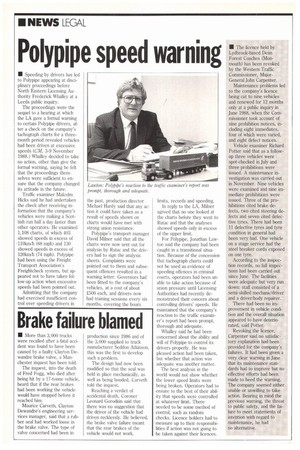Polypipe speed warning
Page 22

If you've noticed an error in this article please click here to report it so we can fix it.
• Speeding by drivers has led to Polypipe appearing at disciplinary proceedings before North Eastern Licensing Authority Frederick Whalley at a Leeds public inquiry.
The proceedings were the sequel to a hearing at which the LA gave a formal warning to certain Polypipe drivers, after a check on the company's tachograph charts for a threemonth period revealed vehicles had been driven at excessive speeds (CM, 3-9 November 1988.) Whalley decided to take no action, other than give the formal warning, saying he felt that the proceedings themselves were sufficient to ensure that the company changed its attitude in the future.
Traffic examiner Malcolm Hicks said he had undertaken the check after receiving information that the company's vehicles were making a Scottish run half a day faster than other operators. He examined 1,108 charts, of which 403 showed speeds in excess of ,110km/h (68 mph) and 130 showed speeds in excess of 120km/h (74 mph). Polypipe had been using the Freight Transport Association's Freightcheck system, but appeared not to have taken follow-up action when excessive speeds had been pointed out.
Admitting that the company had exercised insufficient control over speeding drivers in the past, production director Michael Hardy said that any action it could have taken as a result of speeds shown on charts would have met with strong union resistance.
Poly-pipe's transport manager David Milner said that all the charts were now sent out for analysis by Rutac and the drivers had to sign the analysis sheets. Complaints were pointed out to them and subsequent offences resulted in a warning letter. Governors had been fitted to the company's vehicles, at a cost of about 2500 each, and drivers now had training sessions every six months, covering the hours
limits, records and speeding.
In reply to the LA, Milner agreed that no one looked at the charts before they went to Rutac and that the analyses showed speeds only in excess of the upper limit.
For Polypipe, Jonathan Lawton said the company had been caught in a transitional situation. Because of the concession that tachograph charts could not be used as evidence of speeding offences in criminal courts, operators had been unable to take action because of union pressure until Licensing Authorities had recently demonstrated their concern about controlling drivers' speeds. He maintained that the company's reaction to the traffic examiner's report had been prompt, thorough and adequate.
Whalley said he had been concerned about the ability and will of Polypipe to control its drivers properly. He was pleased action had been taken, but whether that action was adequate was another matter.
The best analysis in the world would not show whether the lower speed limits were being broken. Operators had to ensure to the best of their ability that speeds were controlled at whatever limit. There needed to be some method of control, such as random checks. Licence holders had to measure up to their responsibilities if action was not going to be taken against their licences.












































































































